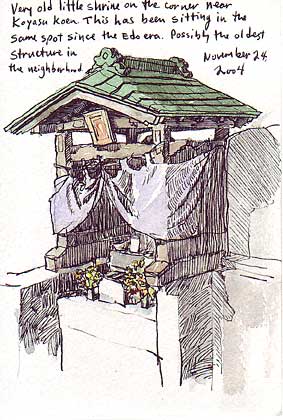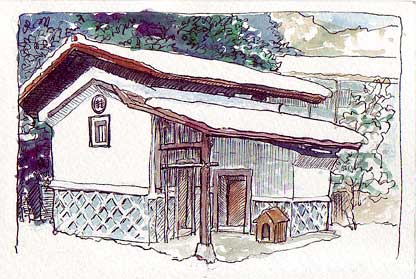|
|
|
|
 | ||
|
Page 21 Postcard sketches For several years there has been a postcard sketching boom in Japan. Art stores and stationery stores have displays of waterbrushes, portable watercolor sets and postcard size sheets of watercolor paper, either spiral bound or loose. Some even have standard postcard elements printed on the back, such as the text area and square for a postage stamp. There are many books on the shelves describing how to make illustrated postcards, and suddenly a lot of people have found an escape through sketching in this small format. |

Although it is not my preferred size, I find postcard sketching very convenient when I can't bring any equipment with me. These sketches were both done on postcard size watercolor paper. Fot both of these, I used Platinum carbon ink in a Pelikan fountain pen that I had refitted with an old super flexible Pilot gold nib. The watercolors are from one of my growing number of home made travel sketch boxes. This is a little shrine that sits on the corner of two narrow streets in my neighborhood. According to the sign next to it, it dates from the Edo era. There is an old worn small stone statue inside, and bowls of food and water (sake?) placed in front. It sits on top of a concrete wall which brings it to eye level. The wall is much newer than the shrine itself. |
||
|
The sketch below is from my winter visit to the town of Sarugakyo in Gunma prefecture. This is a "kura" or storehouse. Most old homes in the country here have nearly identical storehouses. It's an old structure, older than the house itself, and the doors are very heavy and hard to open. It has a very spooky atmosphere inside and I think I've only been inside twice in these past 15 years. 
Sarugakyo is a quiet old village surrounded by mountains. It is full of hot springs and hotels which used to flourish when Tokyoites passed through on their way to Niigata for skiing. But now there's a bullet train, and the town is very quiet. In the center of the town is a wonderful coffee shop called Akabe. It has high wood beam walls and the wonderful smell of wood smoke coming from the stove. All day long classical music records are played through an old tube amplifier, and a huge pair of speakers which used to be the sound system in an old movie theater in America. Being an artist himself, Mr. Fujiwara loves to look at sketches of others, so if you do plan a sketch weekend in Sarugakyo make sure to stop by at Akabe and let Mr. Fujiwara enjoy your works. And tell him I said hello. (Note: unfortunately, Akabe apparently went out of business in the year following this article, and the building is currently being used as an office). | ||
Here are two photos of my sketch boxes. The one one the left holds an F3 size sketch book, and the one on the top right takes an F0 size. These two share the same palette, which I transfer back and forth. At the lower right are my postcard size box and pocket size box. I use waterbrushes for all of these except for the F3 size, which has enough room for collapsible water container. My main reason for making these was to be able to hold everything together in one box, and keep my hands free. I can simply open the box and start painting without setting up any additional equipment. The pocket box is very convenient for sketching at a moment's notice.
For those unfamiliar with F sizes, I know very little about them myself, but they seem to be related to French canvas sizes where the F stands for "figure." Here are some F sizes I found in a catalogue. However, I have discovered that the dimensions of F size sketchbooks from different makers can vary by as much as 10 millimeters in either direction. |
Next page >> |
 |